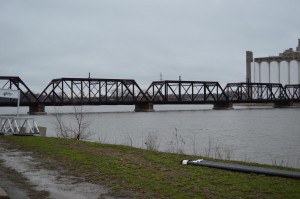
Water levels on the Cedar River rise in northwest Cedar Rapids as rain continues to fall on April 17, 2013. (photo/Cindy Hadish)
Today’s water summary update from the Iowa Department of Natural Resources may seem a gross understatement to residents of Eastern Iowa with flooded basements this week.
The DNR reported this week’s drought monitor continues the improvement trend that began in early March 2013. The area of the state no longer in drought is 35 percent – more than double the area from just one week ago.
Surprisingly, though, the state is somewhat divided, with a portion of west-central Iowa still experiencing shallow groundwater levels as of April 18.
Here is more from the DNR:
Shallow groundwater levels across central, south central, southeast, north central and northeast Iowa have improved substantially in April. Widespread rainfall over the last two weeks has resulted in rising shallow groundwater levels in Fayette County, 6 feet; Johnson County, 10 feet; Marshall County, 4 feet; Lucas County, 2 feet; Boone County, 3 feet; and Hancock County, 3.5 feet. Some improvement has occurred in northwest and parts of southwest Iowa, but water levels are still 1 to 5 feet below April 2012. Shallow groundwater at Denison, in west central Iowa, is at a 12-month low and is 2.8 feet lower than April 2012.
Areas with the highest totals for precipitation thus far in April are in eastern Iowa, where totals have exceeded five inches for the month, or 300 percent of normal. The U.S. Geological Survey is currently reporting that the eastern half of Iowa is experiencing moderate flooding in a line from Dubuque to Chariton.
For a more thorough review of Iowa’s water resource trends April 4 through April 18 go to http://www.iowadnr.gov/watersummaryupdate.
The report is prepared by the technical staff from the Iowa DNR, the Iowa Department of Agriculture and Land Stewardship, and the USGS, in collaboration with the Iowa Department of Homeland Security and Emergency Management Division.

No Comments Yet